Moving Down Market and Up Volume
With the new 2019 Lexus UX 250h, Lexus expands its crossover lineup down market. They are hoping to not only sell younger buyers their first Lexus, but their first luxury car.
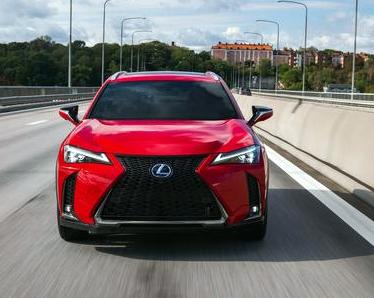
Lexus introduced the industry’s first luxury crossover—the legendary RX—20 years ago, and as part of Toyota enjoys a link to hybrid cars going back almost two decades (to 2005). It makes sense, then, to introduce the UX with gas only and hybrid powertrains. Opt for the UX 200 with its 2.0-liter four or, if you have greener goals, the UX 250h, with a more efficient 2.0-liter engine combined with Lexus’ 4th-generation hybrid system.
Lexus claims that UX stands for Urban X-over (crossover), but it’s also possible that they’ve already used up most of the available letters with their expanded range of crossovers!
While this arrival is being heralded as “new and exciting,” a cynic could say that Lexus looked around and realized that other brands were already selling dinky high-riding mini-utes and they didn’t want to miss out.
The Birth of a New Small Model
As Lexus moves smaller and smaller, it means the UX is the first Lexus to use the shared Toyota small car Global Architecture Compact (GA-C) platform. While this also underpins the humble Corolla, it represents the latest tech for compacts and reduces development costs.
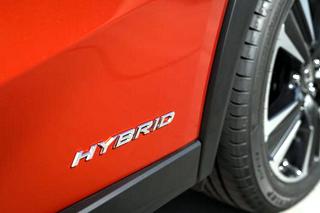
As a Lexus, this newborn gets the same gaping maw up front, but the texture is a clever block-shape mesh pattern that gives a different appearance depending on your viewpoint. That should have an impact in close, urban environments (including Japan). The Takumi (artisan in Japanese) clay modeling process was used to refine the surfaces, which is a challenge with all the different lines a Lexus has to wear these days. Despite the issues of downsizing design cues onto a smaller platform, Lexus has delivered a good-looking vehicle.
Lexus claims that some of the design elements have practical value, such as the Aero Stabilizing Blade Lights in back. It could possibly make a difference at high speed, but we all know that with crossovers, any SUV features, including wheel arch moldings for protecting against flying gravel, are all for show.
The Color Palette
In the EV industry, white and blue are commonly used to communicate high-tech efficiency, so it’s nice to know that only the hybrid version of the UX gets Ultra White and Ultra Sonic Blue Mica 2.0 paint options. You can pick from 10 more hues, too. Cadmium Orange and Nori Green offer multilayer applications and enlarged mica particles for dramatic effect. These are great selling points for millennials, who are apparently more interested in looking good in town than getting covered in mud off-road.
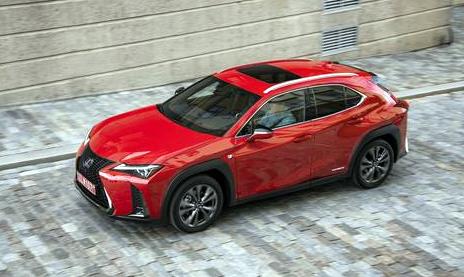
There are three levels—base, F Sport, and Luxury, all with standard all-wheel drive. My test car, in the aforementioned Ultra Sonic Blue Mica 2.0 paint, was an F Sport, so the block pattern on its grill was made up of individual L-shaped pieces! You get L-shaped chrome moldings, too.
But it’s not just about looks. The F Sport UX 250h receives exclusive suspension tuning with revised springs and stabilizer bars for a tighter ride. It also flaunts more rigid 18-inch unique wheels. One hopes the urban jungle’s roads don’t communicate too much to the passengers.
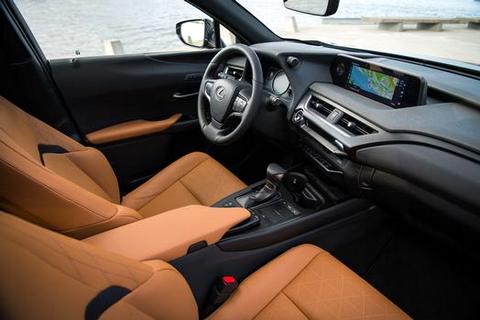
That could be mitigated by the F Sport exclusive interior, with sport seats made with special foam. The cockpit takes inspiration from its super luxury siblings, including the clever sliding ring in the instrument panel and perforated-leather steering wheel.
Inspiration from Home–& Beyond
Lexus employed the Japanese concept called engawa, in having the upper part of the instrument panel look like it extends out beyond the windshield and into the fenders. While it’s an interesting aesthetic, much like living in an Eichler house with its floor-to-ceiling windows, Lexus claims practical benefits (like those aerodynamic taillamps). They claim the design aids in parking in small spaces.
Japanese traditions are fine, but Chief Engineer Kako spent time in Europe to define the UX’s interior appearance and quality. Lexus offers a wide selection of interior color combinations, such as Glazed Caramel and Birch with Lapis—or Circuit Red in the F Sport.
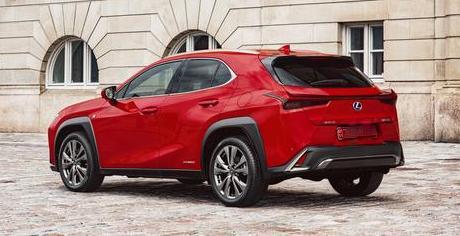
How much benefit does the hybrid provide? The EPA numbers show that every UX is efficient. The 250h, with its additional motor and battery, is 300 pounds heavier, but earns six mpg better numbers overall than the 200 (41 mpg city/38 highway/30 combined vs. 29/37/33, respectively). You can see that most of the improvement is in town—perfect.
The 200 and 250h base models are just $2,000 apart. The UX 250h starts at $34,000, the F Sport at $36,000, and the Luxury begins at $39,200. My tester ended up at $42,785 with some options. That’s the going rate for little luxury crossovers these days.
In order to give you the best perspective on the many vehicles available, Clean Fleet Report has a variety of contributors. When possible, we will offer you multiple perspectives on a given vehicle. This comes under SRO-Second Road Test Opinion. We hope you’ll enjoy these diverse views–some are just below—and let us know what you think in comments below or at publisher@cleanfleetreport.com.
John’s view of the Lexus UX—Comparison Test of the 200 vs 250h
Gary’s view of the Lexus UX 250h
Larry’s view of the Lexus UX 250h
Related Stories You Might Enjoy—Other Small Crossover Options
Road Test: 2017 Infiniti QX30
Road Test: 2015 Buick Encore
Road Test: 2018 Mazda CX-3
Road Test: 2018 Toyota CH-R
Road Test: 2016 Honda HR-V
Flash Drive: 2018 Ford EcoSport
Make sure to opt-in to the Clean Fleet Report newsletter (top right of page) to be notified of all new stories and vehicle reviews.
Disclosure:
Clean Fleet Report is loaned free test vehicles from automakers to evaluate, typically for a week at a time. Our road tests are based on this one-week drive of a new vehicle. Because of this we don’t address issues such as long-term reliability or total cost of ownership. In addition, we are often invited to manufacturer events highlighting new vehicles or technology. As part of these events we may be offered free transportation, lodging or meals. We do our best to present our unvarnished evaluations of vehicles and news irrespective of these inducements.
Our focus is on vehicles that offer the best fuel economy in their class, which leads us to emphasize electric cars, plug-in hybrids, hybrids and diesels. We also feature those efficient gas-powered vehicles that are among the top mpg vehicles in their class. In addition, we aim to offer reviews and news on advanced technology and the alternative fuel vehicle market. We welcome any feedback from vehicle owners and are dedicated to providing a forum for alternative viewpoints. Please let us know your views at publisher@cleanfleetreport.com.
